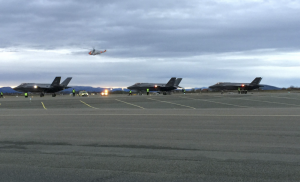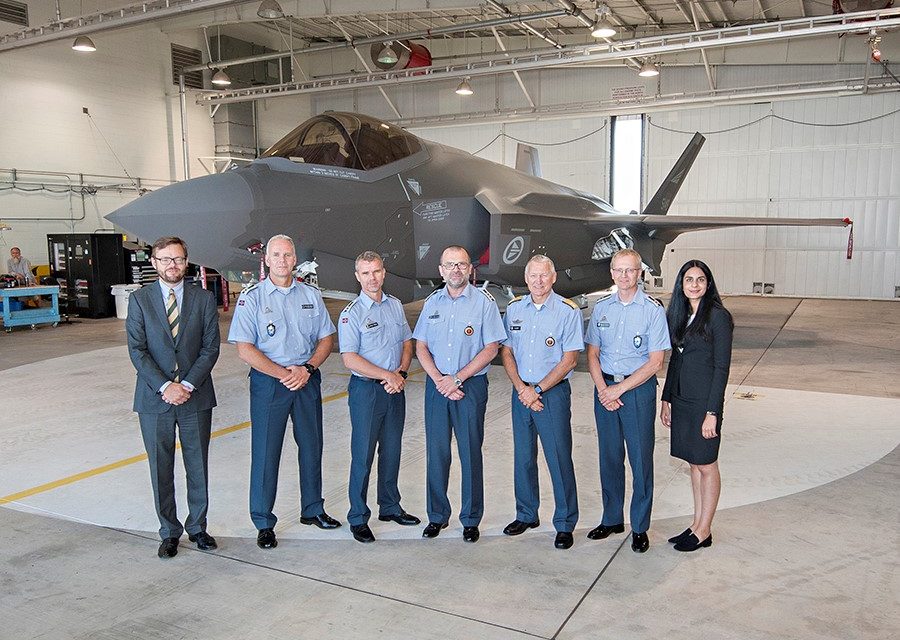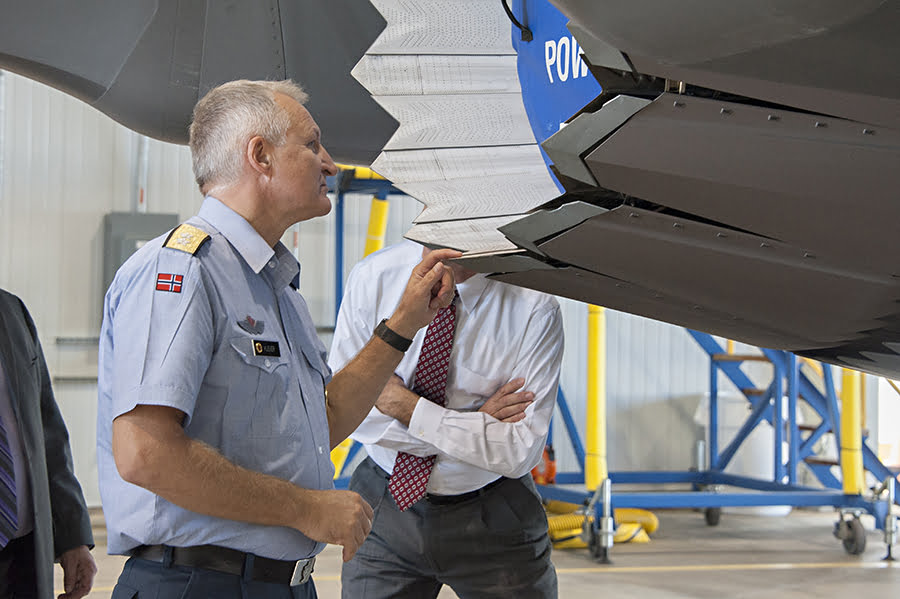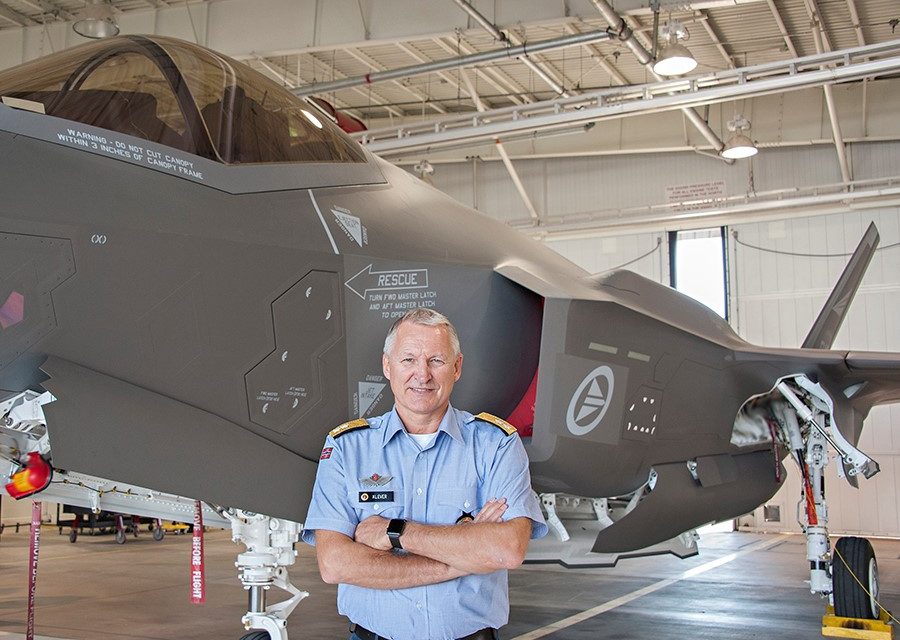2017-11-10 (Updated with Comments on Arrival Ceremony)
According to a story on the Ministry of Defence Norwegian website published on November 10, 2017, the comments by the Prime Minister were highlighted regarding the arrival of the F-35 in Norway.
The F-35 remains crucial to the continued modernization of our Armed Forces and our ability to preserve Norwegian and allied security and interests. The Government marked the procurement with a ceremony at Ørland Air Base November 10th. – Today, we are marking an important milestone in the development of Norway’s defence capabilities: The arrival in Norway of the first F-35 Lightning II jets, says Prime Minister Erna Solberg.
We mark the start of a new era for the Norwegian Armed Forces. The new combat aircraft will be a key factor in deterring any attack on Norway, as well as ensuring that we meet our obligations to the NATO alliance. The F-35 remains crucial to the continued modernization of our Armed Forces and our ability to preserve Norwegian and allied security and interests, says Minister of Defence Frank Bakke-Jensen.
The F-35 is a 5th generation multi-role combat aircraft. It is a key procurement that ensures stronger and more relevant Norwegian Armed Forces in the future. The F-35 provides the Norwegian Armed Forces with a significantly strengthened strategic capability, in terms of sensors, weapons and survivability. This helps ensure that Norway is able to present any future opponent with a credible threshold against military aggression or coercion.
We live in a more and more uncertain world. NATO is undertaking the biggest strengthening of our collective defences in decades. The Norwegian F-35 aircraft are an important contribution to this modernization and make the world’s strongest Alliance even stronger, says NATO Secretary General Jens Stoltenberg.
The F-35 is a lot more than simply an F-16 replacement. It adds a wide range of capabilities to our Armed Forces that Norway have never had before. The F-35 is not just a new fighter. It is a completely new weapons system.
Norway’s participation in this programme enhances our ability to cooperate with other NATO countries, and at the same time gives us additional capabilities that we could never have acquired on our own. This illustrates the value of the Alliance we are a part of. It also shows that we are shouldering our share of the responsibility for ensuring that NATO has modern and effective capabilities, says Prime Minister Erna Solberg.
https://www.regjeringen.no/en/aktuelt/mottaksseremoni-for-f-35-10.-november/id2578465/
The earlier piece starts here:
As Major General Tonje Skinnarland. the Norwegian Chief of Staff, put it in an interview earlier this year:
“It is not just about adding new platforms; it is about shaping joint capabilities for the defense of Norway in a high intensity operational setting.
“To achieve integrated defense and joint operations will not be easy and certainly will not happen simply by adding new platforms.
“There are a lot of different tasks to be done ranging from getting all the spare parts, logistics, the training, and, of course, shaping the national defense plan.
“As we get all these new systems, which will make us even more capable of handling the current situation and current threats together with other allies and partners, there is another challenge.”

The Norwegians like the Danes are introducing the F-35, not as an end in itself air combat asset, but as part of an overall transformation process.
As the chief of the Danish Air Force put it in an interview earlier this month:
“We need to focus on the management of big data generated by the F-35 and other assets that will come into the force.
“How do we do the right kind of command and control within a rich information battlespace?
“We need to build self-learning systems as well.
“The F-35 is a revolutionary man-machine system and sets in motion not only the challenge of new approaches to working information and C2, but new approaches to combat learning.
“How do we get there?
“That is what generating a fifth generation combat force is all about.”
The Norwegians have started the process of incorporating the F-35 in country with the arrival of their first F-35s.
According to a story published by The Barents Observer on November 3, 2017:
The three first of the multi-role aircraft landed at Ørland Air Force Station in central Norway on November 3nd after more than 10 hours in the air from the United States.
A week later, on the day of the Royal Norway Air Force’s 73rd anniversary, the arrival will officially be celebrated.
“The future has landed,” reads the headline for the news article posted at Norway’s Ministry of Defense a few minutes after landing Friday afternoon.
Others call it a “Game changer.”
F-35 will replace Norway’s current fleet of F-16 fighter jets.
With the new planes, the Armed Forces significantly strengthens its strategic capability, not only with more aircrafts than today’s fleet, but firstly because the F-35 has better weapons, sensors and survivability.
“This helps ensure that Norway is able to present any future opponent with a credible threshold against military aggression or coercion,”the Defense Ministry says in a statement.
With the arrival of F-35, the military moves the main base from Bodø north of the Arctic Circle to Ørland Air Force Station northwest of Trondheim, more than 400 kilometers south of the Arctic Circle.
In the north, Evenes airport near Narvik will serve as a forward operating base to offer Quick Reaction Alerts for Norway’s Arctic airspace.
Since 2007, Norwegian fighter jets have frequently been scrambled by NATO to identify Russian strategic bombers flying out in international airspace via the Barents Sea and further south outside the coast of northern Norway.
Norway like Denmark is in the process of raising its defense spending to deal with its challenging neighborhood.
According to a Norwegian MoD press release dated October 12, 2017:
The Norwegian government continues to give priority to the defence sector in its annual budget proposal through a NOK 3 billion increase in 2018. It shows the government’s commitment to increase defence spending every year to meet the ambitions set out in the Long Term Plan “Capable and sustainable” for the defence sector for the years 2017-2020. In a more complex and dangerous world, Norway continues to invest in its Armed Forces.
In developing the Armed Forces capabilities, the government continues to invest in defence in order to achieve the ambitious goals set out in the Long Term Plan for the period 2017–2020. In 2017 we increased the budget with NOK 1,48 billion in order to close identified gaps in maintenance, spare parts and stockpiling.
The 2018 budget allows us to continue closing these gaps while simultaneously implementing the second phase of the plan; improved readiness levels, increased manning in our combat units and increased training and exercise levels, stated the minister of defence Ine Eriksen Søreide.
Of the NOK 3 billion increase, over NOK 2 billion are allotted to the measures set forth in the Long Term Plan. In addition, funding for acquisition of three new Coast Guard vessels, participation in international operations and hosting NATOs High Visibility Exercise Trident Juncture in 2018, are provided funding in the budget proposal.
The Long Term Plan has a three-phased approach with subsequent building blocks to ensure a sustainable balance between resources, capabilities and ambitions. The first phase began in 2017 with increased allocations to maintenance, spare parts and stockpiling.
The second phase with reduced readiness levels, increased manning in Norwegian combat units and increased training and exercise levels, provides for a better trained, properly manned and equipped force structure, with and increased ability to react timely. The third phase, set to begin in 2019, continues a high level of investment and provides for the acquisition in new strategic capabilities to maintain situational awareness and control in the high north.
The NOK 3 billion increase in 2018 provides for:
- Increased manning of the frigates and increased sailing
- Acquisition of Ground Based Air Defence capabilites for the Army
- Establishment of a new ranger company in Finnmark
- A smooth transition from F-16 to F-35 combat aircraft.
- The continued building at Ørland air station for the new F-35 fighter jets
- The preparation of Evenes air station, which will house new P-8 maritime patrol aircraft and be a forward operation base for the F-35 combat aircraft
- A high level of activity for the Norwegian Navy and Coast Guard
- Reception and implementation of the new supply ship HNoMS Maud
The budget proposal strengthens our armed forces. Together with our Allies we have pledged to increase defense spending in order to protect our mutual values, security and interests at home and abroad. Our aim is to ensure that the armed forces have the training, equipment and support necessary for their work. This budget provides for exactly that, states the minister of defence.
Major General Morten Klever, the program director of the Norwegian F-35 program, commented recently on his visit to the Final Assembly Line of the F-35 in Fort Worth.
I have, together with a team from the Armed Forces and Defense, been in Forth Worth in the US to watch the planes coming to Norway in November.
I can report that all three aircraft are ready to fly home soon. The planes have rolled out of the factory, and are now in the final phase as they are piloted and tested thoroughly, so we are sure that everything will work before flying to Norway.
So far everything is on route and we are looking forward to seeing the planes landing on Ørland.
We also visited Fort Worth’s production line, where you can follow the whole process of assembling the planes. It’s an impressive piece of work, and soon it’s the capacity of this factory to roll out an airplane every other day from the 1.8-kilometer-long factory hall.
Here we also saw that all the 6 Norwegian aircraft that will be delivered to Ørland next year are in different places in production. It shows that we are on track with the battlefield acquisition.
Now, just waiting to get our first planes home so the Armed Forces can start training here at home.
http://nettsteder.regjeringen.no/kampfly/
Major General Klever also explained the upgrade process for the F-35 and how it affects the Norwegian F-35 force.
Our seven combat aircraft have 3i software and can be upgraded to 3F software. The upgrade takes a few hours on each flight.
The F-35 aircraft are built in annual production series, where every series up to the one now being built at full capacity is slightly different. That is, all the planes built today, which are production series 9, must be upgraded to reach the level characterized as combatable status.
Our three first flight arriving in Ørland in November comes with so-called 3F software. These three Norwegian aircraft are among the first to come from the production line with this new software.
An Easy Upgrade
The seven aircraft Norway has already received and used for training and training at the Luke Air Force Base in the United States, are earlier production series (7 and 8) and are supplied with 3i software.
These will be upgraded with new software when this fits with the training plan on the base where they operate on a daily basis, and this is a simple process.
Simply explained, you can say that all production series from 7 upwards can be upgraded to the 3F version by making a simple software upgrade. This takes a few hours on each flight and is comparable to upgrading our own iPhone from iOS 10 to iOS 11.
The aircraft in production series 1 to 6, however, can not do this simple software upgrade as they have “old” hardware that can not run the new version software. That is, their iPhone is too “old” and upgrades must be made on the phone itself before it can receive and use the new software.
It’s not as easy to replace these planes as an iPhone, and it is therefore planned to upgrade the aircraft with both hardware and software rather than buying new aircraft…..
Maintain Combat Power and Operational Ability
From the Norwegian side, we have planned from the start that all the aircraft we purchase should be upgraded to 3F software without further modifications, and have therefore purchased aircraft from series 7 and upwards.
The Armed Forces need 52 battle-ready combat aircraft to meet the threats of the future, thus fulfilling the Storting’s goal for the entire combat aircraft acquisition. Now it will also be said that 3F will not be the latest version on our aircraft either, as the planes will be upgraded throughout their lifetime, both with new software and hardware to meet the threats that may develop over the next 40 years.
As an example, the latest aircraft we plan to receive in 2024 have both newer hardware and newer software with even better features than those coming to Ørland in November.
Then all Norwegian aircraft will eventually be upgraded accordingly….
It’s about maintaining combat power and operational ability throughout the lifetime of the aircraft – to be relevant.
http://nettsteder.regjeringen.no/kampfly/
There is a unique modification to the Norwegian F-35s, namely its drag chute which is being validated further in Alaska.
https://www.sldinfo.com/f-35-eielson-debut/
https://www.sldinfo.com/preparing-for-deployment-in-alaska-testing-the-norwegian-drag-chute/
Editor’s Note: For a recent interview with a senior Norwegian defense official on the evolution of Norwegian defense and security policy, see the following:
For a look at the F-35 and its role in Northern European and North Atlantic defense, see the following:
https://breakingdefense.com/2017/05/allies-and-21st-century-weapons-the-f-35-comes-to-europe/
https://breakingdefense.com/2017/04/allies-can-help-us-lower-weapons-costs-build-new-force/
The photos in the slideshow highlight the visit of Major General Klever to Fort Worth with the exception of the last one which was shot during a visit of Second Line of Defense to the F-35 FAL on September 25, 2107.
Major General Klever’s comments in Norwegian were translated by Second Line of Defense.






